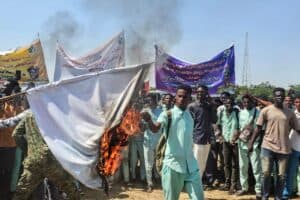Here is what we know so far about the rapidly evolving violence.

Over 300 people have died and hundreds wounded in ongoing battles between Sudan’s regular army and a powerful paramilitary force after long-running bitter brinkmanship spilled into conflict.
At its heart lies two rival generals, army chief Abdel Fattah al-Burhan and his deputy, Mohamed Hamdan Daglo, commander of the large and heavily armed paramilitary Rapid Support Forces (RSF), formed from members of the Janjaweed militia that led years of extreme violence in Darfur.
Together, they seized power in a 2021 coup.
On Saturday, their jostling for power erupted into violence, both in the capital Khartoum and other cities across Sudan, with deafening explosions, air strikes, artillery fire and intense gunfire in densely packed neighbourhoods.
ALSO READ: Japan to evacuate its citizens from Sudan
Each general accused the other of starting the fight, and both have made claims they control key sites, which could not be independently verified.
On Thursday, the sixth day of fighting, explosions and gunfire echoed out in Khartoum, with thousands fleeing the city of more than five million people.
Here is what we know so far about the rapidly evolving violence:
– Why did rivalry become conflict? –
In October 2021, Burhan and Daglo together orchestrated a coup, upending a fragile transition to civilian rule that had been started after the 2019 ouster of longtime autocrat Omar al-Bashir.
Burhan, a career soldier from northern Sudan who rose the ranks under the three-decade rule of now jailed Bashir, took the top job.
Daglo, from Darfur’s pastoralist camel-herding Arab Rizeigat people, assumed responsibility as his number two.
ALSO READ: Almost 200 dead, 1,800 wounded in Sudan battles – UN
But it was only ever “a marriage of convenience”, according to independent researcher and policy analyst Hamid Khalafallah.
“It was never a genuine alliance or partnership, they just had to tie their interests together to face the civilians as a united military front,” Khalafallah added.
The rift widened, with Daglo — commonly known as Hemeti — coming to call the coup a “mistake” that has failed to bring about change and invigorated remnants of Bashir’s regime.
As the army and civilian leaders came together to hammer out a deal to end the political crisis that began with the coup, the integration of the RSF into the regular army became a key sticking point.
For Alan Boswell, Horn of Africa director at the International Crisis Group, Daglo saw in the agreement an opportunity to become “more autonomous from the military” and enact “very large political ambitions”.
ALSO READ: Fighting rages in Sudan as death toll passes 100
According to analyst Kholood Khair, a December framework agreement for the deal “ratcheted up tensions between Burhan and Hemeti,” when it “elevated Hemeti’s position into Burhan’s equal, rather than his deputy”.
– Who are the RSF? –
Created in 2013, the RSF emerged from the Janjaweed fighters that now-jailed Islamist dictator Bashir unleashed against non-Arab ethnic minorities in the western Darfur region a decade earlier, drawing accusations of war crimes.
The infamous militiamen were part of a campaign of terror that saw Bashir indicted for war crimes, crimes against humanity and genocide by the International Criminal Court.
Experts estimate the RSF number as many as 100,000 gunmen.
ALSO READ: Coups, pyramids and chewing gum: five things about Sudan
In 2015, the heavily armed militia was deployed alongside regular Sudanese forces in the civil war in Yemen as part of the Saudi-led coalition, which helped boost Daglo’s profile abroad.
According to experts, the force has also been involved in the conflict in neighbouring Libya.
The RSF has been accused of more atrocities since, in particular as part of a security crackdown after the ouster of Bashir, when at least 128 people were killed in a violent dispersal of a Khartoum sit-in in June 2019.
“The RSF has continued to grow stronger since 2019,” Boswell added.
– What comes next in Sudan? –
According to Boswell, “this is an existential power struggle on both sides”.
As the full-scale fighting entered its sixth day, many suspected that the RSF may be receiving ammunition and supplies from abroad, via neighbouring nations.
Daglo met recently with the son of eastern Libyan military strongman Khalifa Haftar, but Haftar’s spokesman Ahmad al-Mesmari, said Thursday the force “categorically denies” it was backing either side.
Sudan’s west, where the RSF also holds positions on the Chadian border, is also still “awash in weapons”, said Eric Reeves, a fellow at the Rift Valley Institute think tank.
Daglo will try “to use his connection to Chad and his power in Darfur to secure a supply line”, he added.
With both generals out for blood, Khair finds it “unlikely they’ll come to the negotiating table without one or both of them suffering heavy losses”.
Though both continue to make “bellicose” statements against each other, she told AFP, “neither of them will come out of this unscathed”.
ALSO READ: Sudan paramilitaries say in control of Khartoum presidential palace
The longer they battle it out in city streets, she said, the higher the civilian toll climbs and the harder it will be for either general to rule over the wreckage.
“Both sides are strong enough that any war between them will be extremely costly, deadly and long,” said Boswell.
Even with a partial victory for either side in Khartoum, “war will continue elsewhere in the country”, dividing up Sudan into strongholds, he added.
“We’re already in worst case scenario territory, and from here the scenarios only get grimmer and grimmer,” he said, warning the impact will ripple throughout the region.






